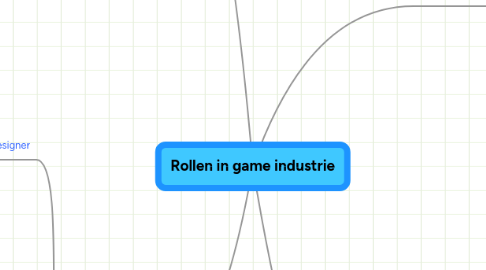
1. Vormgeving
1.1. Game designer
1.1.1. Responsibilities
1.1.1.1. User play experience
1.1.1.2. Working game-play
1.1.1.3. At all level
1.1.1.4. Collaborate
1.1.1.4.1. With almost every other team member
1.1.1.5. Brainstorm concepts
1.1.1.6. Create prototypes
1.1.1.7. Playtests and revise prototypes
1.1.1.8. Write concept and design documents
1.1.1.8.1. update it throughout production
1.1.1.9. Communicate vision for the game to the team
1.1.1.10. Create levels for the game
1.1.1.10.1. Or work with level designers
1.1.1.11. Act as a advocate for the player
1.1.2. Fills in for
1.1.2.1. Producer
1.2. Writer
1.2.1. Responsibilties
1.2.1.1. Writes the whole story (beginning, premise, ending etc) of the game and presents it to the other designers/artists.
1.3. Art director
1.3.1. Responsibilities
1.3.1.1. Leads the team of artists and tells the other artists what do do and how.
1.4. Creative director
1.4.1. Responsibilities
1.4.1.1. Keep consistent look and feel across a company's entire product line.
1.4.1.2. Guiding game designers trough problems
1.5. Artist
1.5.1. 3D artists
1.5.1.1. Responsibilities
1.5.1.1.1. Texture Mapper
1.5.1.1.2. 3D Modeling
1.5.2. Character designer
1.5.2.1. Responsibilities
1.5.2.1.1. Does research and creates the characters that are used in the game.
1.5.3. Illustrators
1.5.3.1. Responsibilities
1.5.3.1.1. Creates the illustration that are used in the game, for example the box cover or illustrations in the instruction booklet.
1.5.4. Concept Artist
1.5.4.1. Responsibilities
1.5.4.1.1. Create the environments of characters and works with character designer on characters
1.6. Interface Designer
1.6.1. Responsibilities
1.6.1.1. Create interface elements that interact with the content
1.6.1.2. Work with game designers to create a coherent user experience
1.7. Animators
1.7.1. Responsibilities
1.7.1.1. Creates the animations of the characters in the game for the programmers to work with.
1.8. Lever designers
1.8.1. Responsibilities
1.8.1.1. Designs and sometimes create the levels the player can play in.
2. Techniek
2.1. CTO
2.2. Programmer
2.2.1. Senior programmer
2.2.1.1. Responsibilities
2.2.1.1.1. Lead Programmers
2.2.1.1.2. Oversee testing
2.2.1.1.3. Document framework needs
2.2.2. Responsibilities
2.2.2.1. Drafting technical specifications
2.2.2.2. Implementing technical aspects
2.2.2.2.1. Software prototypes
2.2.2.2.2. Software tools
2.2.2.2.3. Game modules and engines
2.2.2.2.4. Data structures
2.2.2.2.5. Management of communications
2.2.2.3. Documenting code
2.2.2.4. Coordinating with QA engineers to fix or resolve bugs
2.3. Specific specialization
2.3.1. Tools programmer
2.3.1.1. Responsibilties
2.3.1.1.1. Setup version control
2.3.1.1.2. Setup testing framework
2.3.1.1.3. Document API
2.3.2. Engine programmer
2.3.2.1. Responsibilities
2.3.2.1.1. Document Engine
2.3.2.1.2. Platform control
2.3.3. Graphics programmer
2.3.3.1. Responsibilties
2.3.3.1.1. Document Graphics API
2.3.3.1.2. Work with Game Designers
2.3.4. Database programmer
2.3.4.1. Responsibilities
2.3.4.1.1. Create database schema
2.3.4.1.2. Maintenance Database
2.3.4.1.3. Scaling Database
3. Management
3.1. Project leader
3.1.1. Responsibilities
3.1.1.1. Lead Project
3.1.1.2. Control Budget
3.1.1.3. Main communication link
3.1.1.3.1. Between developer and publisher
3.1.1.4. Delivery of the game to the publisher as promised
3.1.1.5. Presenting the team
3.1.1.5.1. At conferences
3.1.1.5.2. In the press
3.1.1.6. Making tough decisions
3.1.1.6.1. Hiring and firing employees
3.1.1.6.2. Saying no to excessive resource or spending requests
3.1.1.7. Appoint resources
3.2. Producer
3.2.1. Producer
3.2.1.1. Responsibilities
3.2.1.1.1. Schedule and budget
3.2.1.1.2. Track and allocate resources
3.2.1.1.3. Manage team
3.2.1.1.4. To complete on time
3.2.1.1.5. Creates the plan
3.2.1.1.6. Motivate team
3.2.1.1.7. Solve production related problems
3.2.2. Assistant producer
3.2.2.1. Helps Producer with daily tasks
3.2.2.2. Plans Agenda
3.2.2.3. Identifies problems early on
3.2.3. Senior producer
3.2.3.1. Oversee multiple productions
3.2.3.2. Guides Producers
3.2.4. Development director
3.2.4.1. When the game designer is also producer he takes over some conflicting responsibilities
3.2.4.2. Oversees development in all sections
3.3. QA Engineers
3.3.1. QA lead
3.3.1.1. Manage floor operations
3.3.1.2. Manage resources
3.3.2. QA Engineer
3.3.2.1. Responsibilities
3.3.2.1.1. Create test plan
3.3.2.1.2. Execute test plan
3.3.2.1.3. Record
3.3.2.1.4. Manage issues
3.3.2.1.5. Retest after fixes
3.3.2.1.6. Check if designs work properly
3.3.2.1.7. Check if games functions work
3.3.2.1.8. Review wireframes/Prototypes
3.4. Executive
3.4.1. Responsibilities
3.4.1.1. Lead managers
3.4.1.2. Ensure propper funding
3.4.1.3. Make though calls
3.4.1.4. Understanding trends
3.4.1.5. Contact with press
4. Geluid
4.1. Sound Editor
4.1.1. Responsibilties
4.1.1.1. Selection sound effects
4.1.1.2. Mix recordings
4.1.1.3. Editing Recordings
4.2. Voice Artist
4.2.1. Responsibilities
4.2.1.1. Records the vocals for a character in the game
4.3. Musician
4.3.1. Responsibilities
4.3.1.1. Compose and create the music played in the game.
